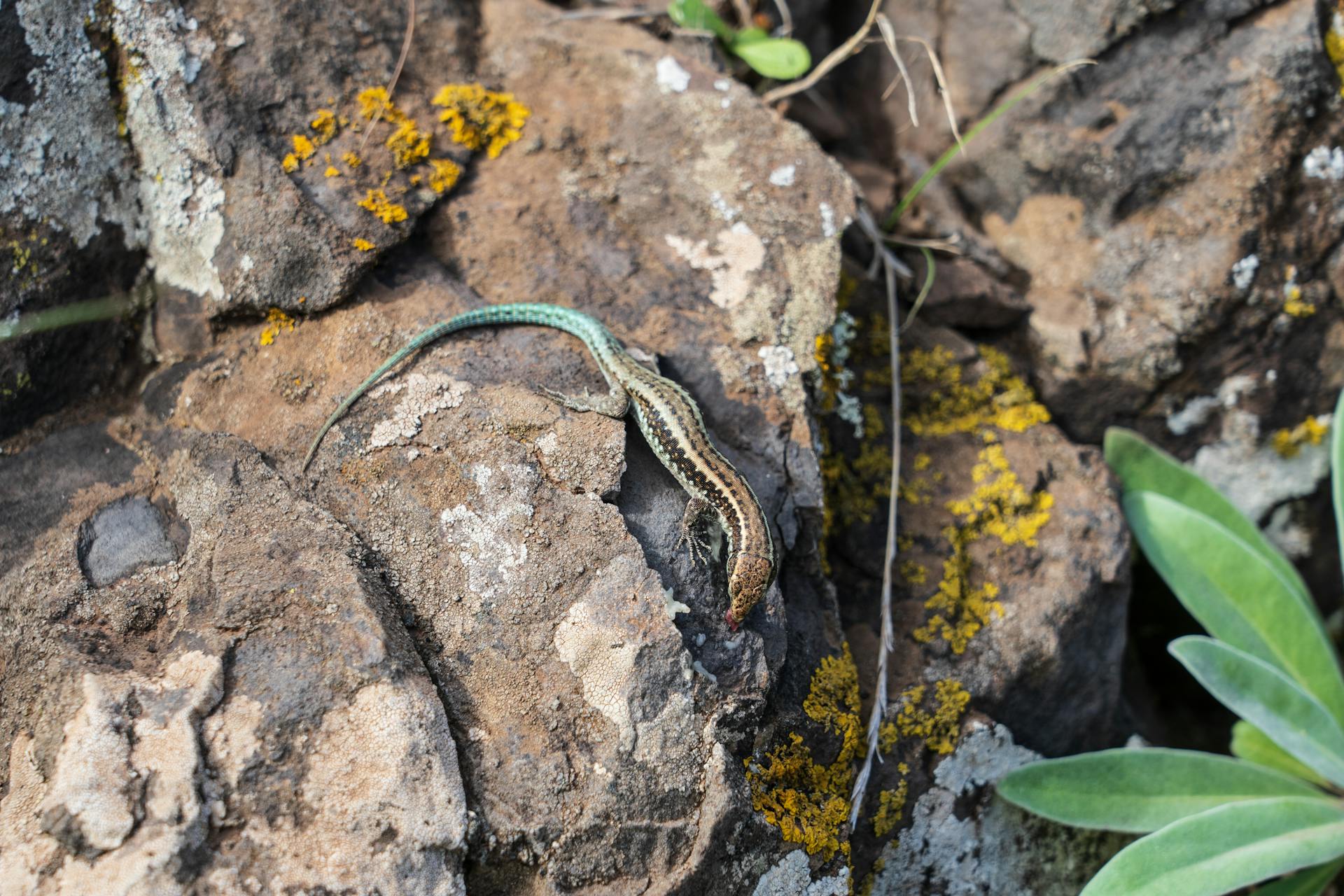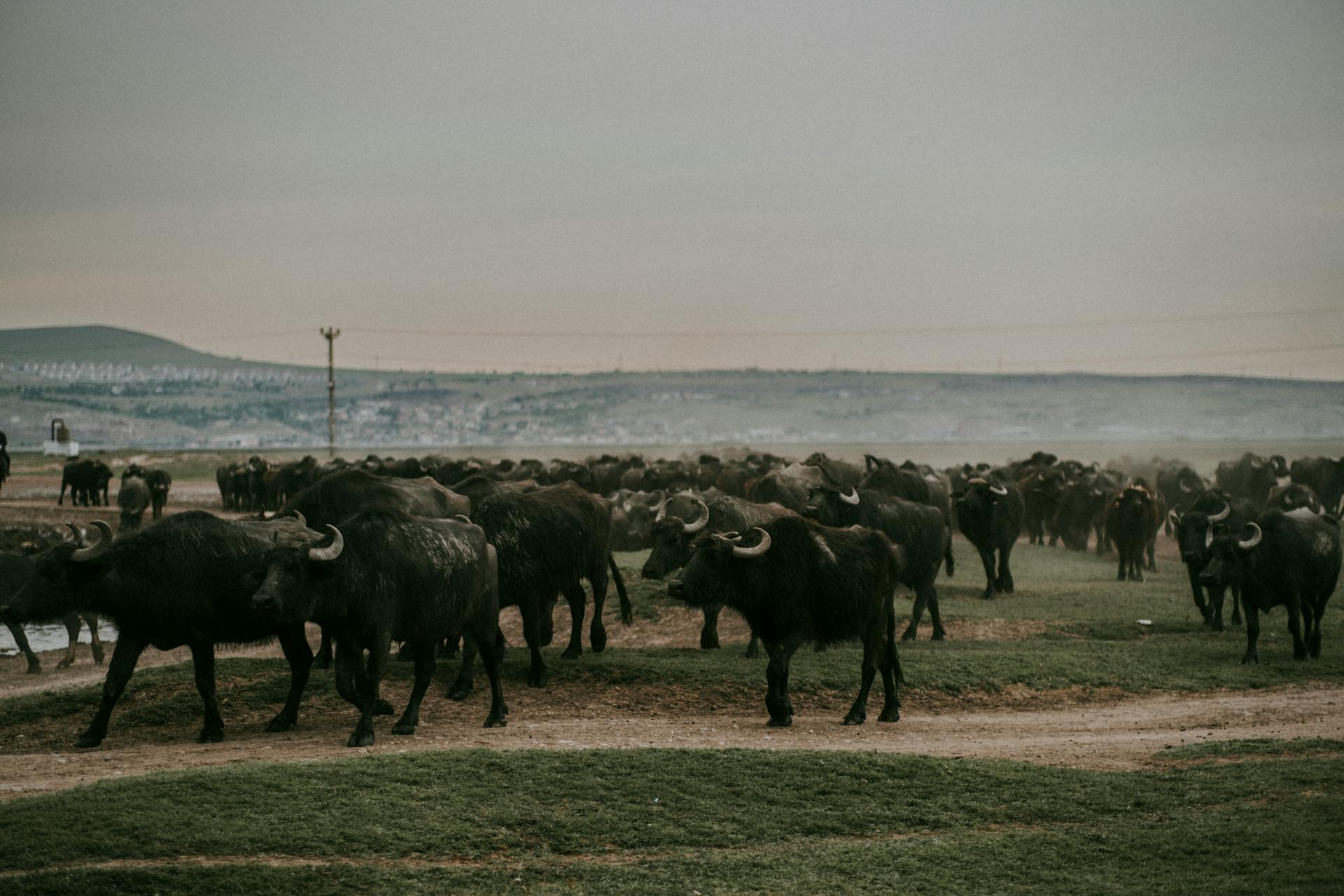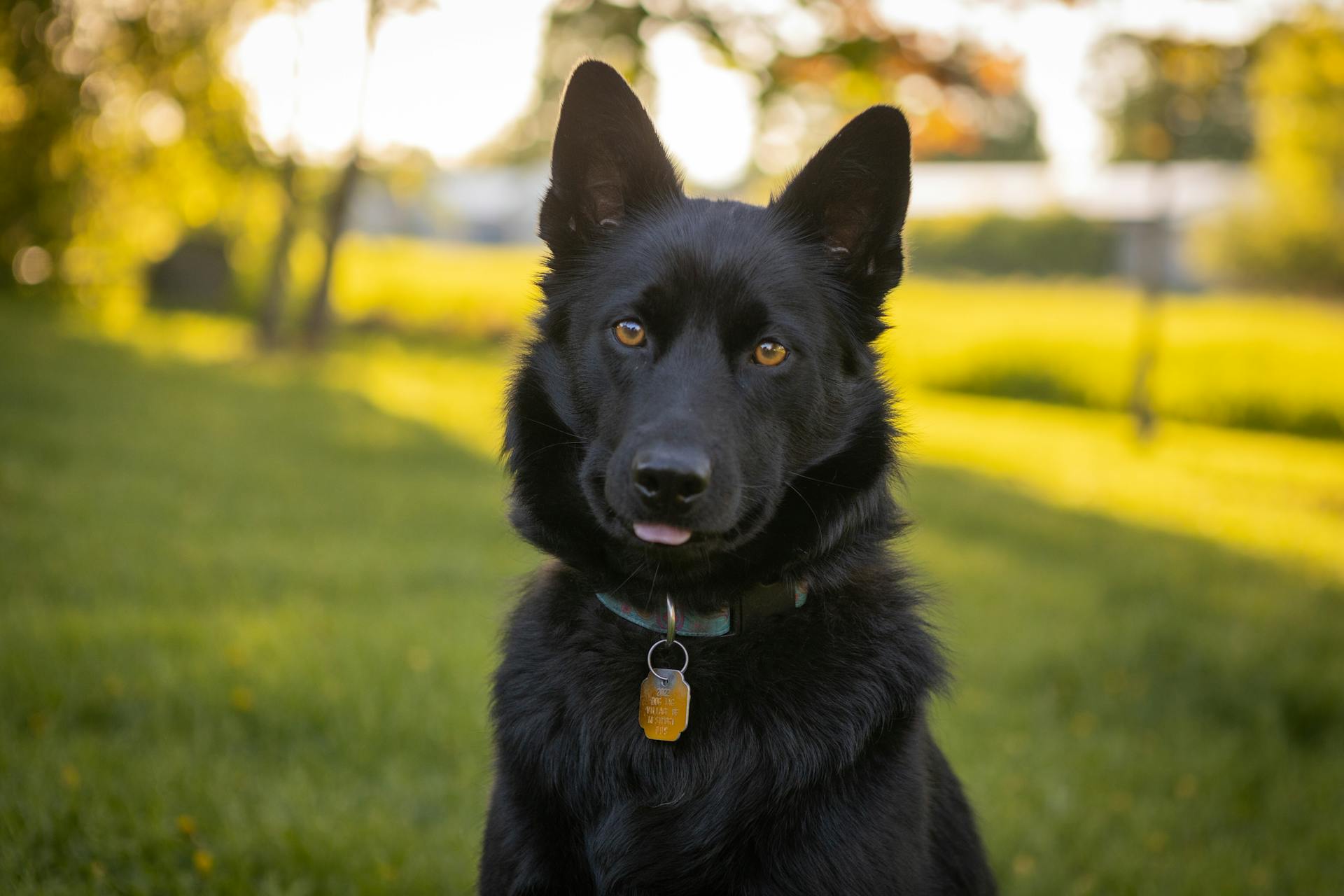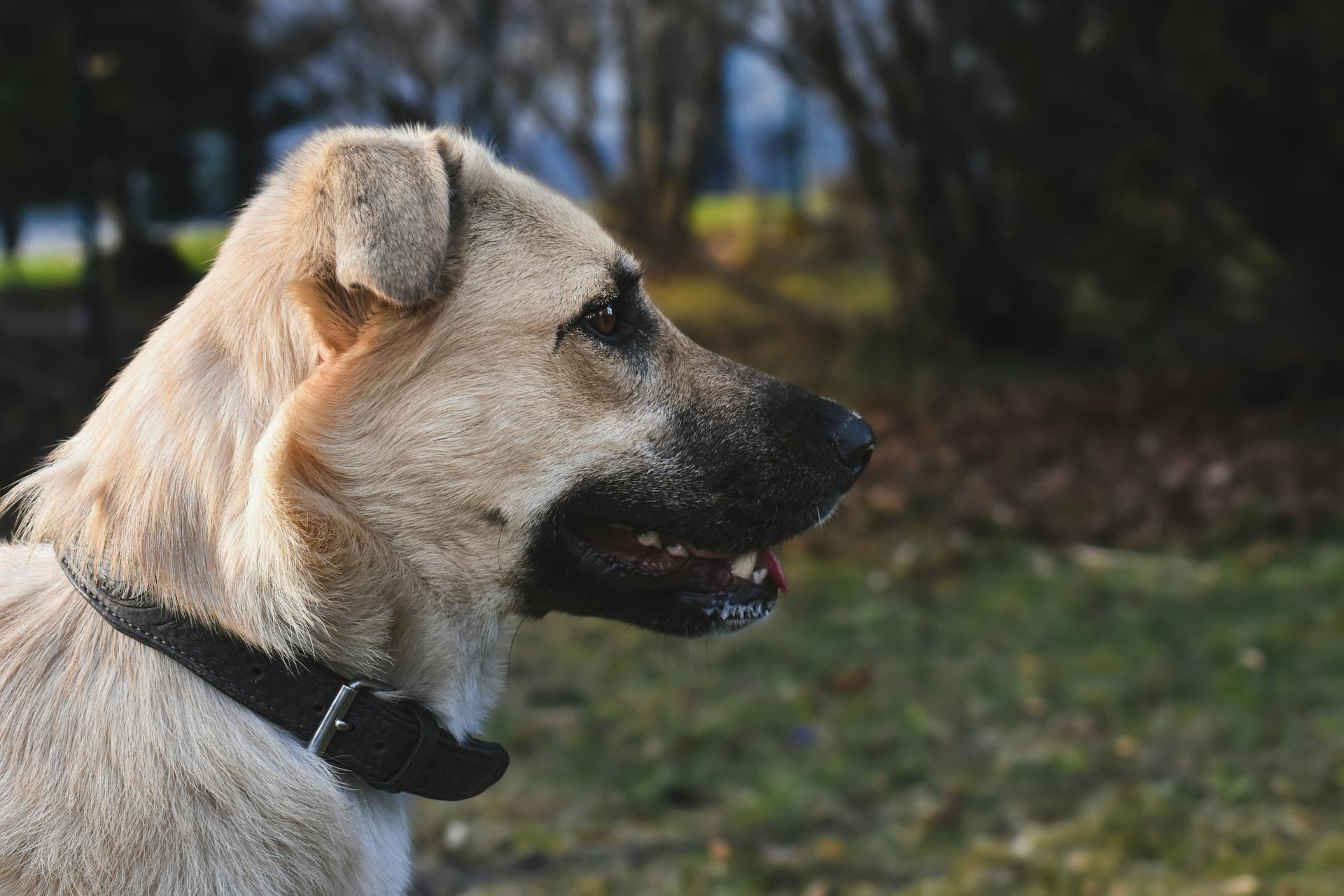
The Anatolian and Great Pyrenees are two popular breeds of livestock guardian dogs that have been used for centuries to protect sheep and other animals from predators. Originally from Turkey, the Anatolian is an ancient breed that has been around for over 6,000 years.
The Great Pyrenees, on the other hand, hails from the Pyrenees Mountains between France and Spain. This breed has a rich history dating back to the 15th century. They were originally bred to guard sheep and other livestock from wolves and other predators.
Despite their differences in origin, both breeds share some similarities. They are both large dogs with thick coats, built for rugged terrain and harsh weather conditions. They also have a strong instinct to protect and defend their flocks.
But what sets these breeds apart? Let's dive into the key differences and similarities between the Anatolian and Great Pyrenees.
Discover more: Great Pyrenees Breed Standard
Livestock Guardian Dogs
Livestock guardian dogs have been selectively bred for thousands of years to possess specific traits, including a low prey drive and a strong instinct to protect their herd.
These dogs are incredibly protective of their animals, bonding with them and living with them to defend them from predators. They're often independent and don't need much human instruction, preferring to make their own decisions.
Most livestock guardian breeds are large dogs, capable of fighting against wolves, large cats, and even bears. They have a double coat of hair that provides excellent insulation against extreme weather.
If you're considering getting a livestock guardian dog, research the breeds and their pedigree to find the best fit for your needs. Temperaments and reactivity levels can vary greatly between breeds.
Here are some key traits to look for in a livestock guardian dog:
- Low prey drive
- Strong instinct to protect their herd
- Independence and ability to make their own decisions
- Large size and ability to defend against predators
Keep in mind that some breeds may not be suitable for families with small animals, such as baby goats, as they may view them as prey.
Great Pyrenees Breed
The Great Pyrenees is an ancient breed dating back thousands of years, originating in the Pyrenees Mountains to protect livestock from predators. They're a giant breed with a well-proportioned, muscular body.
Discover more: Is a Great Pyrenees a Giant Breed
Their thick double coat is designed to protect them from harsh weather conditions, with a long and straight outer coat and a dense and soft undercoat. Coat colors are usually white, and tan, gray, or badger markings may be present, especially around the head and ears.
As a breed, the Great Pyrenees can face several health problems due to their large size, including hip and elbow dysplasia, bloat, and obesity, which can lead to health issues like diabetes and cardiovascular disease.
Recommended read: When Do Great Pyrenees Get Their Full Coat
Great Pyrenees
The Great Pyrenees breed has a rich history dating back thousands of years, originating in the Pyrenees Mountains to protect livestock from predators.
They are a giant breed with a well-proportioned, muscular body and a thick double coat designed to protect them from harsh weather conditions.
Their head is large and proportional to their body, with a slightly rounded skull, and the ears are moderate in size and triangular in shape.
Coat colors are usually white, and tan, gray, or badger markings may be present, especially around the head and ears.
The Great Pyrenees can face several health problems due to their large size, including hip and elbow dysplasia, bloat, and obesity.
Obesity can lead to several health issues, including diabetes and cardiovascular disease.
Other issues include osteosarcoma and white dog shaker syndrome.
They require experienced owners who understand their temperament and can provide proper training and socialization.
If you're considering a Great Pyrenees as a guard dog, be aware that they have a strong protective instinct and may not be suitable for all households.
They can be wonderful family dogs, are usually gentle with children, and can give a sense of security to the household.
However, as one owner experienced, Great Pyrenees may not be the best choice for households with baby goats, as they may attack them.
Consider reading: Common Problems with Great Pyrenees
Origin
The Great Pyrenees breed has a rich history that dates back thousands of years. They originated in the Pyrenees Mountains between France and Spain, where they were used as livestock guardians to protect sheep and other animals from predators.
Their ancestors were likely influenced by the Anatolian Shepherd, another ancient breed that originated in the Anatolian Peninsula, which includes modern-day Turkey. This breed has a lineage dating back thousands of years and was also used as a livestock guardian.
The Great Pyrenees were bred to be intelligent, adaptable, and protective, with a strong instinct to guard their flock. They were able to thrive in the challenging terrain and climate of the Pyrenees Mountains.
Temperament & Intelligence
The Great Pyrenees and Anatolian Shepherd breeds are known for their gentle and patient nature, making them great family pets. They're generally friendly and well-suited to family life, but early socialization and training are essential to bring out their best qualities.
The Great Pyrenees is a former livestock guardian, which means they have close contact with various farm animals in their blood, and they typically get along well with other dogs and even cats in the home. However, their history as guard dogs can make them strong-willed, so consistent training is crucial.
See what others are reading: Great Pyrenees Potty Training
Anatolian Shepherds, on the other hand, are intelligent and competent, but they can be independent and sometimes aren't overly friendly with people or pets they don't know. Socialization and training are key to ensuring they become comfortable around kids and other types of people outside their immediate families.
Both breeds are loyal and loving to their family, but they require a lot of exercise and attention to prevent boredom. The Anatolian Pyrenees, in particular, can become unruly if they don't receive early and proper training, making them unsuitable for novice dog owners.
A different take: Training a Great Pyrenees
Owning a Large Breed Dog
Owning a large breed dog requires a significant investment of time and effort, but it's a commitment that can be incredibly rewarding. They instinctively look to protect their pack and can be fiercely protective, so proper training is essential.
If you're willing to put in the work, a large breed dog can make an excellent family pet. They can be fiercely protective, but with proper training, they learn to look after themselves without being aggressive.
A fresh viewpoint: What Does a Great Pyrenees Dog Look like
A working dog breed like the Anatolian Pyrenees needs an owner who is committed to spending time with them. Their protective and loving nature means that the effort is well worth it.
Proper training not only prevents bad habits, but it also teaches them they are part of a pack that can look after itself. This can lead to a strong bond between you and your dog.
At a Glance
These two breeds have some key differences. The Anatolian Shepherd stands at an average height of 27-29 inches, while the Great Pyrenees can reach up to 32 inches tall.
Both breeds have a significant weight range, with the Anatolian Shepherd weighing between 80-150 pounds and the Great Pyrenees weighing over 80 pounds.
In terms of lifespan, both breeds have a relatively long life, with the Anatolian Shepherd living for 11-13 years and the Great Pyrenees living for 10-12 years.
When it comes to exercise, the Great Pyrenees requires a lot more attention, needing at least an hour of exercise per day, whereas the Anatolian Shepherd is happy with 30-60 minutes of exercise daily.
Grooming needs also vary between the two breeds, with the Anatolian Shepherd requiring moderate grooming and the Great Pyrenees needing very little.
Here's a comparison of the two breeds' characteristics:
Breed Overview
The Anatolian and Great Pyrenees are both ancient livestock guardian breeds that have been protecting flocks for centuries. They share some similarities, but they also have some key differences.
The Anatolian is a smaller breed, weighing between 80-120 pounds, while the Great Pyrenees can weigh up to 160 pounds. They have a sturdy build, but the Great Pyrenees is generally more massive.
Anatolians are known for their high energy levels and require plenty of exercise to stay happy and healthy. They are often used in active farming settings where they can run freely with the animals they're guarding.
Great Pyrenees, on the other hand, are calm and gentle, making them a great choice for families with children. They are also relatively low maintenance when it comes to exercise, needing only moderate activity to stay content.
Both breeds are naturally protective of their flock, but they have different instincts and temperaments. Anatolians are more alert and vigilant, while Great Pyrenees are more laid-back and trusting.
Breed Characteristics
Anatolian Shepherds are not ideal for first-time dog owners due to their independent and strong-willed nature.
They require a firm but fair handler who understands their guarding instincts and can provide consistent training.
Farmers and ranchers who need a capable and protective livestock guardian may find this breed an excellent fit for their operations.
Anatolian Shepherds also make excellent watchdogs and can give their owners a strong sense of security.
Additional reading: Difference between Kangal and Anatolian Shepherd
Appearance
The Anatolian Shepherd is a large breed with a dense double coat designed to protect them from harsh weather conditions. Their coat is made up of two layers: a short to medium outer coat that can be rough, and a soft and dense undercoat.
Their head is large and proportionate to their body, with a slightly rounded skull. A strong square-shaped muzzle completes their distinctive head shape.
Discover more: Great Pyrenees Coat Colors
Suitable for:
Anatolian Pyrenees and Shepherds can thrive in households with experienced owners who understand their protective instincts. They can be fiercely protective, so it's essential to socialize and train them well.
A different take: Great Pyrenees Protective
Their independent nature makes them a great fit for farmers and ranchers who need a capable livestock guardian. They can give their owners a strong sense of security.
They're not ideal for first-time dog owners, as they require a firm but fair handler who can provide consistent training. They're strong-willed and need a handler who understands their guarding instincts.
Readers also liked: How Much Exercise Does a Great Pyrenees Need
Frequently Asked Questions
Is Anatolian Shepherd the strongest dog in the world?
The Anatolian Shepherd Dog's strength is subjective and can be measured in various ways, including biting force and physical prowess. While it's strong, it's not definitively the strongest dog in the world.
Why are Anatolian Shepherds considered to be great guard dogs?
Anatolian Shepherds are great guard dogs due to their keen senses of hearing and sight, allowing them to detect potential threats. Their instinct to bark at intruders makes them a formidable deterrent against unwanted visitors.
Are Anatolian Shepherds calm dogs?
Yes, Anatolian Shepherds are calm dogs, but they can also be intense protectors of their loved ones. Their calm nature is balanced by a strong and demanding personality that requires a confident leader.
Sources
- https://backyardgoats.iamcountryside.com/ownership/livestock-guardian-dog-breed-comparison/
- https://be.chewy.com/dog-breeds/compare/great-pyrenees-vs-anatolian-shepherd/
- https://www.hepper.com/anatolian-shepherd-great-pyrenees-mix/
- http://forums.barrelhorseworld.com/forum/forums/thread-view.asp
- https://www.hepper.com/anatolian-shepherd-vs-great-pyrenees/
Featured Images: pexels.com


